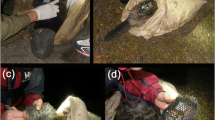Abstract
To determine the accuracy of radio-tracking estimates of activity and distances walked by European bisonBison bonasus (Linnaeus, 1758), we observed bison while simultaneously conducting radio-tracking in the Bialowieża Forest (Poland). Single radio-tracking estimates often did not represent the actual activity of the bison, but the mean time spent active calculated from radio-tracking and direct observations did not differ significantly. Radio-tracking provided overestimates of the distances walked by bison when the animals walked between 0 and 25 m and underestimated the distances walked by bison if they walked further than 25 m in a radio-tracking interval. Activity was best estimated when radio-trackers were between 200 and 300 m from the bison. The mean activity calculated with a sampling interval of 15 min needed about 8 days of radio-tracking and the mean of distances walked about 35 tracking days to stabilise. We concluded that collars without activity sensors can measure the mean activity of bison but cannot represent the length of their activity bouts or the type of their activity and that our radio-tracking estimates of distances walked by bison needed to be corrected before further analyses.
Similar content being viewed by others
References
Caboń-Raczyńska K., Krasińska M. and Krasiński Z. A. 1983. Behaviour and daily activity rhythm of European bison in winter. Acta Theriologica 28: 273–299.
Cederlund G. 1981. Daily and seasonal activity pattern of roe deer in a boreal habitat. Viltrevy 11: 315–353.
Cederlund G. and Lemnel P. A. 1980. Activity recording of radio-tagged animals. Biotelemetry 7: 206–214.
Cousse S., Janeau G. and Spitz F. 1992. Telemetry on free-ranging wild boars (Sus scrofa L.): temporal and spatial structure of daily movements. [In: Wildlife telemetry — remote monitoring and tracking of animals. I. G. Priede and S. M. Swift, eds]. Ellis Horwood: 693–697.
Demarchi M. W. and Bunnell F. L. 1995. Forest cover and activity of cow moose in summer. Acta Theriologica 40: 23–36.
Faliński J. B. 1994. Concise geobotanical atlas of Bialowieża Forest. Phytocoenosis 6: 1–88.
Georgii B. 1981. Activity patterns of female red deer (Cervus elaphus L.) in the Alps. Oecologia 49: 127–136.
Georgii B. and Schröder W. 1983. Home range and activity patterns of male red deer (Cervus elaphus L.) in the Alps. Oecologia 58: 238–248.
Heezen K. L. and Tester J. R. 1967. Evaluation of radio-tracking by triangulation with special reference to deer movements. The Journal of Wildlife Management 31: 124–141.
Jeppesen J. L. 1989. Activity patterns of free ranging roe deer (Capreolus capreolus) at Kalø. Danish Review of Game Biology 13: 1–30.
Kenward R. E. 1987. Wildlife radio tagging. University Press, London: 1–222.
Kolenosky G. B. and Johnston D. H. 1967. Radio-tracking timber wolves in Ontario. American Zoologist 7: 289–303.
Krasińska M., Krasiński Z. A. and Bunevich A. N. 2000. Factors affecting the variability in home range size and distribution in European bison in the Polish and Belarussian parts of the Bialowieża Forest. Acta Theriologica 45: 321–334.
Krasiński Z. A. 1967. Free living European bison. Acta Theriologica 12: 391–405.
Musiani M., Okarma H. and Jêdrzejewski W. 1998. Speed and actual distances travelled by radio collared wolves in Bialowieża Primeval Forest (Poland). Acta Theriologica 43: 409–416.
Palomares F. and Delibes M. 1991. Assessing three methods to estimate daily activity patterns in radio-tracked mongooses. The Journal of Wildlife Management 55: 698–700.
Russo L., Massei G. and Genov P. V. 1997. Daily home range and activity of wild boar in a Mediterranean area free from hunting. Ethology Ecology and Evolution 9: 287–294.
Saltz D. 1994. Reporting error measures in radio location by triangulation: a review. The Journal of Wildlife Management 58: 181–184.
Schmidt K. 1999. Variation in daily activity of the free-living Eurasian lynx (Lynx lynx) in Bialowieża Primeval Forest, Poland. Journal of Zoology, London 249: 417–425.
Springer J. T. 1979. Some sources of bias and sampling error in radio triangulation. The Journal of Wildlife Management 43: 926–935.
White G. C. and Garrot R. A. 1990. Analysis of wildlife radio tracking data. Academic Press, San Diego: 1–383.
Author information
Authors and Affiliations
Corresponding author
Rights and permissions
About this article
Cite this article
Rouys, S., Theuerkauf, J. & Krasińska, M. Accuracy of radio-tracking to estimate activity and distances walked by European bison in the Bialowieża Forest, Poland. Acta Theriol 46, 319–326 (2001). https://doi.org/10.1007/BF03192438
Received:
Accepted:
Issue Date:
DOI: https://doi.org/10.1007/BF03192438




